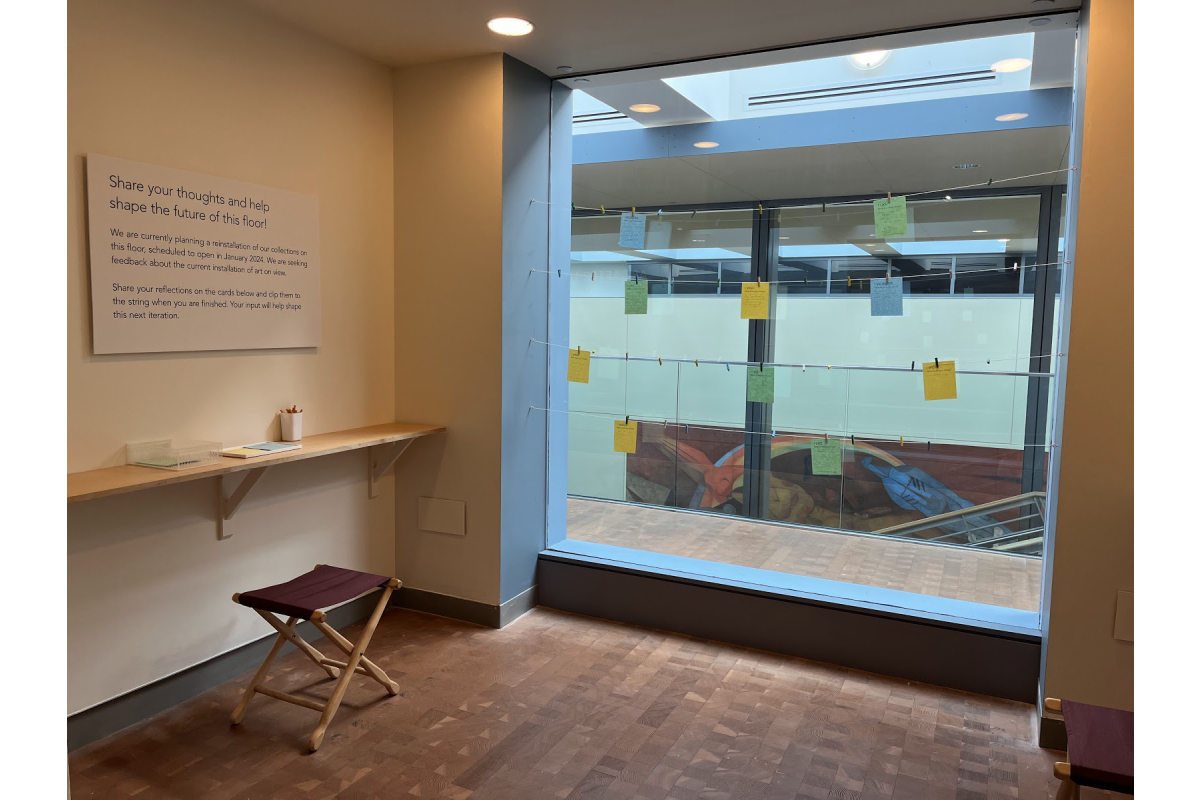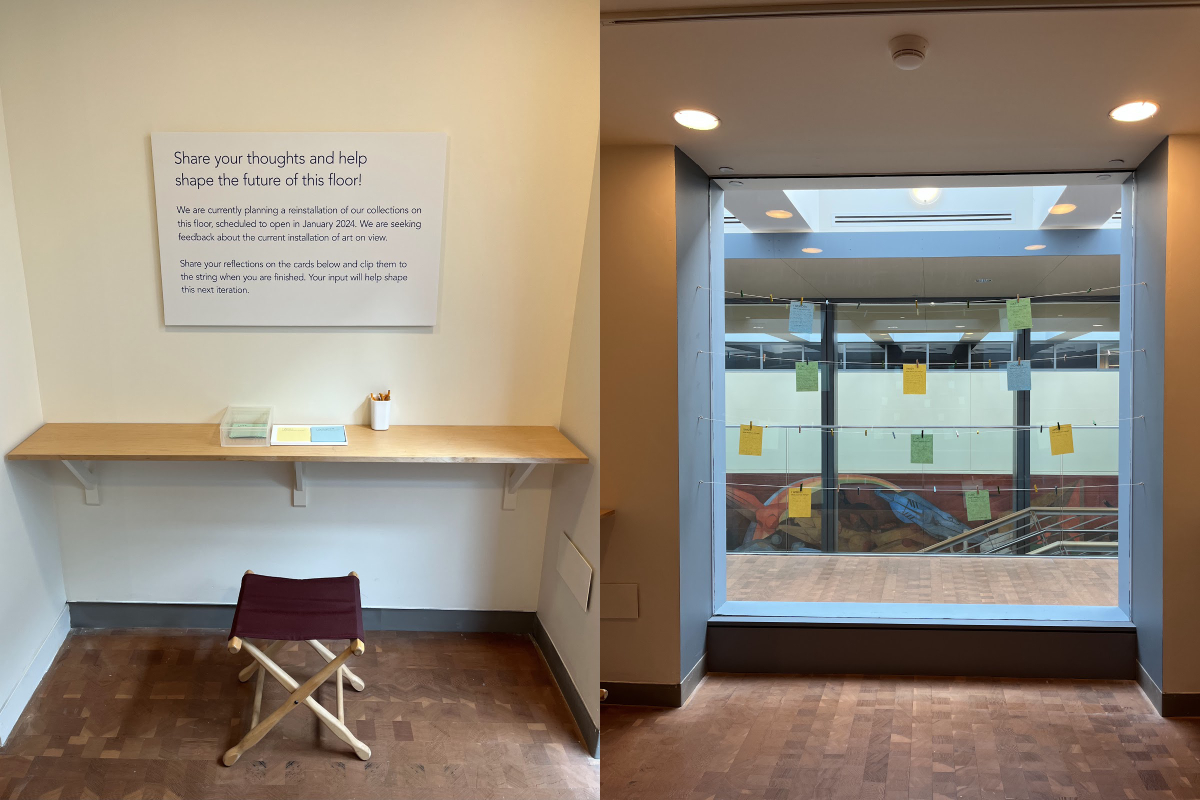
“I Like,” “I Wish,” “I Wonder:” Reimagining SCMA’s Third Floor Collections Gallery using Visitor Evaluation
Interpretation and Educational Programming Assistant Emily Valin ‘23J discusses how visitor feedback is informing the museum’s reinstallation of its collections.
Why is the third floor gallery being reinstalled?
During my time as the Interpretations and Programming Assistant this past semester, I have had the chance to collaborate with the core team that is working on SCMA’s upcoming reinstallation project. In the summer of 2023, the museum will deinstall all the art on its third floor while the building’s roof is renovated. SCMA is using this as an opportunity to reimagine the space to better reflect the museum’s core values, as well as the needs of Smith students and other visitors. To better understand how visitors feel about the current installation, the project team—which includes curatorial, education, collections management, visitor services staff, and two students (including me)— installed an interactive station for collecting visitor feedback. Decisions made about the reinstallation—which is scheduled to open in January 2024— are being informed by visitor input collected in the space and through group dialogues with Smith students, museum staff, and other colleagues. The feedback provided by visitors has helped the museum further acknowledge past shortcomings and is helping shape the future of not just the third floor, but the entire museum. It has been exciting to see new feedback come in each week and to be a part of a project where students, staff, and visitors are being involved in such a large-scale change to the museum.
Throughout this past semester, we have held focus group meetings on the third floor to see how people with different backgrounds/connections to the museum use the museum and what their experience is like. The Museum Advisory Collective (MAC), which is a group of about 30 Smith students, recently participated in a focus group meeting about the third floor. During this meeting, students explored the third floor and shared their insights. The MAC discussed the emphasis on “canonical” art, accessibility, and themes they’d like to see reflected on this floor. Our conversation with the MAC emulated the core planning team’s discussions while also asking new questions and bringing new ideas to light.

Map of Third Floor: Location of Evaluation Station Circled in Red
How is feedback being collected?
To date, STRIDE Scholar Veda Hedgepeth ‘26 and I have collected over 260 comments through the evaluation station. Visitors are invited to participate in this reinstallation process by writing their reflections down on the color-coded cards that follow the prompts “I like,” “I wish,” and “I wonder”. Visitors then clip the cards to string that stretches across the alcove window.
Multiple times throughout the week, Veda and I collect and log these pieces of feedback in a document that is shared with the core planning team. When logging these comments, we categorize them. The following tags are used to categorize the feedback: specific object feedback, labels/texts, architecture/space/light, layout, curatorial approach, representation of subjects, representation of artists, participation/Interpretive layers, accessibility, and not relevant (does not pertain to the museum or art), and other. If it is known, we also tag who provided this feedback. For instance, the cards have an option to mark whether the person giving feedback is a Smith student. This information is helpful in understanding why these comments were made and how different audiences navigate the space. Every comment, no matter who wrote it or what the content or length, is read and logged.

Third floor evaluation station alcove
How is the feedback collected being used?
Each week, Veda and I create a summary of the comments collected. This summary is shared with the Core Team during our weekly Friday meetings. We use these summaries to identify what people like about the floor, questions they have, and changes they would make. These summaries help generate conversations around the changes that need to be made and will help the Core Team make informed decisions during this process.

What are we hearing so far?
It has been so interesting to see how varied the comments are week to week and how the trends we are seeing change. Out of the 260+ responses we have received, about 50% of the comments were from general museum visitors, 30% from Smith students, and the other 20% is a mix from SCMA staff and the Museum Visiting Committee, collected during focus group sessions.
The most popular tags on the comments have remained the same since the evaluation station was installed, with “curatorial approach” being the most popular followed by “specific object feedback” and “architecture/space/light”.
Reflecting back on what the most common ideas were for each of the card prompts, there were a few themes that particularly stuck out. For the “I like” prompt, visitors enjoy the natural light on the floor. It helps make the space feel more open and inviting. As for the “I wish” prompt, there are multiple comments each week about the need for more diverse representation and for more seating throughout the gallery (I agree!). More seating would make the space more accessible to more audiences and give people spaces where they can reflect and gather. Another wish that people have is to have more interactive pieces or materials on the floor. During the Museum Advisory Collective, we spent a lot of time discussing what these interactive materials could look like. There are various marble busts on the third floor, so we discussed how it would be interesting to have a marble piece that visitors could interact with. Having more sensory aspects that connect to the works on the floor would allow visitors to have a better understanding of the materiality and history of the pieces. For the “I wonder” prompt, people are curious about how works are chosen for display and who is involved in this process. This is also a question I’ve had for a while and am still learning more about. Hopefully with the new installation of the third floor, we will see these ideas come to fruition and questions be answered.
What's next?
In the Spring semester, Veda will write a follow-up blog post discussing how the planning process has changed as SCMA is getting closer to the de-installation of the third floor. I am excited to be updated in the Spring, and hope that you all are too!